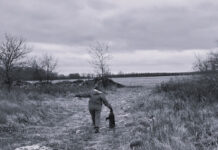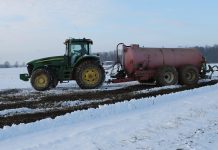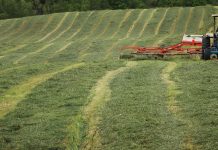Ever since farmers started keeping livestock, they have put up hay every summer for feeding in the winter.
It started with a sickle and scythe, loose hay thrown on wagons and then stored in a large barn. Over the years, tractors and hay equipment were developed to cut down on the time needed for making hay and to increase the area that could be harvested.
Many folks can recall hot, summer days during their youth having to go out and help put up hay. It was a habit and a necessity that came with keeping livestock. Nowadays, my father-in-law can go out and put up tons of hay by himself without hardly getting out of an air-conditioned tractor.
| Item | Cost/1000 lb. Bale | ||
| $/acre | 4 bales/acre | 8 bales/acre | |
| Machine cost to harvest | $95 | $23.75 | $11.88 |
| Fertility Cost/bale | $9.50 | $9.50 | |
| Cost/bale | $33.25 | $21.38 | |
| Supplemental feed | $17 | $17 | |
| Total per bale | $50.25 | $38.38 |
Times, costs change
I am just wondering if most folks have ever stepped back and calculated the real cost of putting up hay these days.
Here are some numbers to think about when you put up hay.
First, you need to have the right equipment. If you don’t already own it, then you are looking at buying new or used equipment. This might include a rotary mower/conditioner, hay rake, baler, and possibly fertilizer spreader and hay trailer. Even if you already own the equipment, there is always depreciation, insurance and storage costs associated with owning the equipment. Since you use one or a couple of tractors to pull all of this equipment, you have to add some tractor cost into the mix.
Pencil it out
Now taking a look at the Ohio State Hay Enterprise budget, the book cost for owning the equipment is around $70/acre. Add in diesel fuel and repair cost and you are at about $95/acre.
I know that some of you can cut costs here and there, but you are going to have to come up with some real numbers before you can convince me that you are doing it any cheaper.
What’s growing?
Now that you have the equipment, you need to have some grass worth cutting. If you already have decent grass growing in your hayfield, then you can save some cost in not having to go through the planting process and all of the associated costs.
I am going to assume that you already have a good stand of grass. There are several different grasses that we could look at. For this exercise, we’ll look at cool season grasses.
In general, our cool season grasses remove 45 pounds of nitrogen, 12 pounds of phosphorus and 50 pounds of potassium with every ton of dry matter taken off the field as hay. So, I took a look at current fertilizer prices and did some calculations. For each ton of dry matter, you are taking off around $38 worth of fertilizer. This doesn’t leave any extra behind any for grass regrowth.
With minimal effort, you might be producing 2 tons of hay to the acre. If you have just put in the minimum inputs and were able to get four 1,000-pound bales per acre, your cost per bale is $33.25. (Most large, round bales usually don’t weigh this much, but it makes the math easier.)
This type of production can actually be the most inefficient. By doubling the fertilizer on good soil, you should be able to double the number of bales per acre. This would bring your price down to $21.38 per bale. This, of course, assumes that your soil is in good condition and you have no weed problems. If not, start adding in a few more dollars.
Feed value
Now it’s time to feed the cows, but you have no idea if it has adequate nutrition for the animals that you are trying to feed. You need a hay analysis. If not, then you will have to guess if the hay is adequate for the stage of production that the cattle are in.
Research shows that if you are feeding hay that doesn’t meet the nutritional requirements of your animals, then you may need to add an additional $17 in supplemental feed costs per bale. If you are keeping up with the numbers, the cost of the poor quality hay is now up to $50.25 per bale for feeding a lactating cow.
Let’s take a look now at the habit of putting up hay. So far, we have accounted for the bare minimum in producing hay. No amount has been accounted for our time and labor and we are at a bale of hay that is costing us somewhere between $38 and $50.
There could be some savings or additional costs. From my experience, these always seem to even out and you end up at the same price.
Take hard look
This is the time when you need to take a good look at the conditions of your hay field and decide what is really needed to make some quality hay. The one question that I have to ask myself is “Am I gaining or losing money by putting up hay?”
I always keep an eye on hay prices and they always seem to be lower than what I can produce myself. Many of those, though, don’t come with any kind of analysis. If I can buy hay with an analysis that meets my herd’s needs for about the same cost, then I might save myself some time and money by having someone else do the work.
The second advantage is that I am bringing in someone else’s nutrients. I can feed the cows what they need and then get the leftovers spread out around the farm to help my own pastures.
In the overall accounting, I could take off the amount of additional nutrients added to my pasture from the cost of the hay.
What’s it worth
If you looked at the numbers real close and looked at your feeding practices, you might find that you could pay an extra $5 to $10 for that 1,000-pound bale and still be ahead.
Of course, there are many factors that go into your decision to cut hay. The main question that you have to ask yourself is if cutting hay is the best management decision for your farm or are you doing it out of habit.













